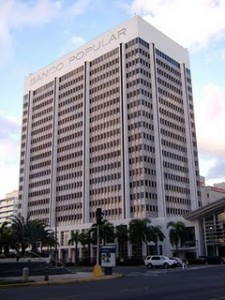Popular, Oriental reduce exposure to government risk


Oriental has reduced its exposure to the Puerto Rico central government and public corporations. (Credit: © Mauricio Pascual)
Puerto Rico’s two largest banks — Banco Popular and Oriental — confirmed separately on Friday that they’re working to reduce their exposure to risk associated with the island’s government, which they have financed in different capacities over the years.
During discussions with analysts about their quarterly results, the top executives at each bank said they are watching over the government’s declining liquidity and threat of a shutdown or default on its upcoming bond payments.
“We believe a comprehensive solution is needed and we are encouraged by the attention Puerto Rico has received from the federal government in recent weeks. But more needs to be done out of Washington and from the local government officials,” said Oriental CEO José Rafael Fernández.
He said Oriental expects its core business to continue to do well “in spite of the challenging economy and assuming that there is no additional economic contraction due to a government shutdown.”
Over the past two years, Oriental has reduced its exposure to the Puerto Rico central government and public corporations from $772 million to $216 million. That amount includes a $194 million loan to the Puerto Rico Electric Power Authority, which was placed on non-accrual status during the first quarter of this year, but continues to generate interest payments for the bank.
“This does not include the $24 million provision we took in the first quarter. As I mentioned earlier, the Ad Hoc bondholders and banks have reached an agreement to work out PREPA’s bond and bank debt. As a result of this progress, there was no need for additional provision,” Fernández said.
Oriental also held a $78 million loan with the Puerto Rico State Insurance Fund, which was completely paid off in the third quarter. This resulted in a $3.2 million cost recovery in interest income on prepayment penalty totaling $800,000 that added to bank service revenue, he said.
The bank also has a $21 million in long-term credit facility to the Puerto Rico Housing Finance Authority. It is repaid from inactive and unclaimed customer deposits from local financial institutions. This loan balance declined 17 percent due to the repayment in the third quarter, Fernández told investors.
The other local government exposure Oriental has is $203 million in loans to five of the island’s largest municipalities that are autonomous from the central government and consequently do not share the same credit characteristics.
The loans also are collateralized and guaranteed by first lien on property taxes and secured by money set aside in special accounts held by the Government Development Bank.

Last quarter, Popular sold its PRASA exposure and moved it to loans held for sale, writing it down by $30 million, or 40 percent.
Banco Popular cuts PRASA loan
Meanwhile, at Banco Popular, CEO Richard Carrión said “regarding our exposure to the Puerto Rico government, our underwriting process, the structure and the size of our exposure relative to our capital base gives us comfort.”
The bulk of Banco Popular’s direct government exposure is in loans to municipalities, not publicly traded securities of the central government or its public corporations, totaling $579 million, a decrease of $94 million from the previous quarter.
“Our direct exposure is down $94 million from the previous quarter as a large majority of our Puerto Rico Aqueduct and Sewer Authrority exposure [$75 million] was repaid and we sold approximately half of our Puerto Rico central government bond portfolio,” Carrión said.
Last quarter, Popular sold its PRASA exposure and moved it to loans held for sale, writing it down by $30 million, or 40 percent.
“We will monitor developments in this portfolio closely and will make future adjustments as needed while selectively participating in funding the Puerto Rico government’s capital needs where we feel the risk-reward is in our favor,” he said.
The bank also sold about half of its Puerto Rico central government bond portfolio. The remaining securities portfolio is primarily composed of senior Puerto Rico Sales Tax Financing Corp. (known as COFINA) bonds.
“Our total exposure to the central government and public corporations is manageable, representing only 2 percent of our total Tier 1 capital,” said Lidio Soriano, executive vice president, chief risk officer at Banco Popular.
Finally, Carrión said the bank will be watchful of the government’s fiscal and liquidity challenges, adding “any successful solution will likely require three things: number one, a legal framework for a debt restructuring; two, an effective fiscal control board; and three, a meaningful economic stimulus plan.”
“We hope that the political leadership will arrive at solutions that will achieve fiscal balance and, more importantly, put the economy back on a growth track, and we will do everything in our power to support that result,” he said, adding the proposal revealed by the U.S. Treasury last week is “promising.”
“This proposal includes many of the elements I mentioned earlier and is worthy of bipartisan support, both locally and in the U.S. Congress. We encourage all of the political parties of Puerto Rico and the private sector to rally behind this plan,” he said.














